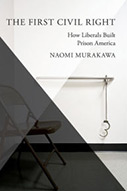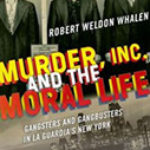The First Civil Right: How Liberals Built Prison America

Author: Murakawa, Naomi
Publisher: New York: Oxford University Press, 2014. 280p.
Reviewer: Jim Finckenauer | September 2015
“One black man in the White House, one million black men in the Big House” (p. 1). With this attention grabbing opening line, Naomi Murakawa begins her critical look at “How Liberals Built Prison America,” as she subtitles her book.
Before going any further, let me offer a mea culpa. Naomi Murakawa takes to task in her book a group of people she calls law-and-order liberals. It is they, Murakawa alleges, who were largely responsible for the mass incarceration dilemma that the country faces today. Not too far into my reading of this book, it became clear to me that I was (and in a sense still am) one of those liberals to whom she is referring and who she says is responsible for building prison America. I did spend most of my professional life engaged in different ways with the very policies, programs and practices that she severely criticizes in the book. So, I do not come to this book as an unbiased and totally objective reader. Whether I can nevertheless be fair and offer valid criticisms will be up to other readers of the book and maybe this review to decide – and I shamelessly advise reading both.
Murakawa has a very definite point of view upon which her arguments, her evidence, and thus ultimately the entirety of her book are premised. She asserts this perspective, for example, early on as follows: “liberals established a law-and-order mandate: build a better carceral state, one strong enough to control racial violence in the streets and regimented enough to control racial bias in criminal justice administration….[m]y overarching claim is …that lawmakers constructed the civil rights carceral state, in which liberal notions of racial violence and agendas for race-neutral machinery actually propelled development of a punitive carceral state” (p. 3). Hers is a complex and nuanced argument, and is therefore difficult to summarize. As with any review, but especially one of a book of this nature, there is the danger of oversimplifying and losing the nuances. Plunging ahead nevertheless, my interpretation of Murakawa’s charge is that liberals, who traditionally were and were expected to be opposed to what had become in the 1960s the strident call for “law and order,” meaning no holds barred tough on crime and criminals, and at the same time were expected to be advocates for minorities (especially African-Americans) in all respects, were instead either ignorant or naïve, or worse, hypocrites. Murakawa seems to lean to the latter view, that these so-called liberals were actually disguised racists, who set about building a system for legitimizing racial violence, while at the same time pretending to be “true” liberals. The end result has been what the author then refers to as the carceral state, a characterization that I will take up shortly.
But first, who were these liberals toward whom the author is pointing her accusatory finger? Ironically, according to several experts who have looked at this same history, they included a substantial number of black leaders of the time. In his new book, Black Silent Majority, Michael Fortner concludes that in the 1960s and 70s, a key time frame in Murakawa’s telling, African-American law and order advocates helped shape the drug and punishment policies that led to mass incarceration. Fortner points out, as Murakawa acknowledges, that later on 13 members of the Congressional Black Caucus co-sponsored the crack cocaine bill of 1986. It is hard to suggest that these members were anti-black racists! Their motivation must therefore have been something else; and that same motivation, I suggest, was behind the efforts of many who wanted to do something about drugs and crime, and who believed the thing to do was to improve and strengthen criminal justice processes and the criminal justice system. Indeed, the guiding premise of the Omnibus Crime Control and Safe Streets Act of 1968 – which provided federal funds for criminal justice reform, and not as Murakawa claims simply distributed funds to state and local police, and also did not as she alleges just fund police equipment and the militarization of the police — was that crime could be controlled and the streets made safer by improving the criminal justice system.
This takes me back to the notion that the criminal justice reformers of the 1960s and 1970s and later were hypocrites who carefully disguised their real intents. I would argue that instead, they (we) were actually more ignorant and naïve than hypocritical. We were ignorant in the sense that we did not really know what would work to control and reduce crime. The necessary research and the careful evaluation of policies and practices to create that knowledge had not been done. Thus, it was necessary to proceed on the basis of the limited information available and simply on theories and beliefs, rather than on evidence. There was, in other words, no such thing as evidence-based programs. And this is where our naiveté came in. We actually thought that despite our limited knowledge, and despite the enormity of the problems (economic, social and political) related to crime, that we really could do something about it by just focusing on improving criminal justice. To cite Michael Fortner again, he writes in a recent Op-Ed piece in the New York Times (September 28, 2015): “Today’s disastrously punitive criminal justice system is actually rooted in the postwar social and economic demise of urban black communities. It is, in part, the unintended consequence of African-Americans’ own hard-fought battle against the crime and violence inside their own communities” (p. A23). A product of ignorance and naiveté?
Throughout the book, Murakawa refers to what she calls the “carceral” state. Carceral is itself an interesting (at least to me) word, for several reasons. It is not often used in discourse and writing on law and justice, and therefore may not be obvious in its meaning when used as an adjective to describe the state. Second, when it has been used, its context has been with reference to jails and especially prisons – thus the link to “incarceration.” I find the description interesting because Murakawa’s subject here is not just jails and prisons and incarceration, but is rather a broad sweep look at the entire criminal justice process, and even beyond that at punishment that is inflicted outside the law, such as lynchings by private persons acting within neither the rule of law nor with due process. Much of her discussion is of the police and police practices, which the author views as an important part of the carceral state . Although the police are certainly the gateway to jail and prison, they themselves are not literally engaged in incarceration. But if one is wanting to create an image of a kind of police state, then obviously the police must be included.
As I understand the author’s meaning, if I were asked to think of examples of what I might regard as a “true” carceral state, what would come to mind would be the Soviet Union with its gulag archipelago so brilliantly described by Alexander Solzhenitsyn; the former GDR (East Germany) where citizens were actually confined within the state and shot if they attempted to escape; or perhaps the Cambodia of Pol Pot and the killing fields; or, maybe North Korea today. Despite the many wrongs and even horrors that stain American criminal justice history, a history that Murakawa accurately documents very well, I find it hard to see them rising to the level of those historical examples, or others that one might think of, and therefore fitting an image of a truly carceral state, of “prison America.” Again, this is not to deny that bad and misguided things have happened, and that there were and are bad or misguided people doing those things, but it is rather to deny that those actions were intended liberal policy and that those particular people necessarily represented and were supported by the state. Some, such as lynch mobs and vigilantes, clearly operated as private individuals, albeit sometimes with the acquiescence of public officials. And some who were public employees or officials abused the powers of their office and/or operated outside the law. But in neither case did such persons represent nor have the support of liberal policy – law-and-order or otherwise.
Here, one might recall the adage that the road to hell is often paved with good intentions — or one might substitute benign intentions. Various of the policies and practices to which the author refers did indeed produce undesirable unintended outcomes. Murakawa’s point is that these policies and practices helped lead to the problem of mass incarceration that we have today, and no doubt that is true. What is troubling to me, however, is the author’s allegation that these outcomes were what was intended all along. For example, she claims that “liberal Democrats defined `the crime problem’ as a subset of `the Negro problem.’” This suggests, or more than that asserts, that so-called liberal law-and-order was deliberately advocated and adopted as a racist anti-black set of policies and practices designed to combat and control black criminals. This allegation does not fit at all with my experience and the people I knew and worked with.
Beyond this principal objection, there are a number of other assertions or conclusions by the author with which I would take issue. For instance, Murakawa criticizes the effort to bring in procedures and professional training in order to define the acceptable use of force by the police (these are her italics). Is she implying that the police should not and cannot ever use force? That seems unlikely. So if not, then how should that necessary use of force be controlled and regulated, assuming that is a desirable objective? Further with respect to the police, the author refers to efforts to improve police-community relations by reducing or eliminating the conditions that can lead to dissatisfaction, unrest and rioting (seemingly a worthwhile goal) as suppressing impetuses for rioting – a curious choice of words that certainly convey a very different meaning!
One of the author’s criticisms of the legacy of liberal law-and-order is “we evaluate the rightness of criminal justice through the administrative quality by which each individual is searched, arrested, warehoused, or put to death” (p. 18). Indeed there have been considerable efforts from many quarters over the past 50 years to achieve justice as fairness – to insure that like cases are treated alike, without bias or prejudice, and to try to achieve the goal of equality of all persons before the law. Have these efforts been entirely successful? No! But to dismiss them as just administrative enhancements seems unjustified.
On page 43, Murakawa makes this observation about liberal reformers achievements: “to be imprisoned or killed through due process of law preserved the nation’s moral fabric.” This triggers two thoughts – first, due process of law is not something to be sneered at; and second, linking (as this statement does) imprisonment and capital punishment seems at a minimum to be unfair. There are many people in this country who see imprisonment as an appropriate punishment for certain serious crimes, but who oppose the death penalty. And with respect to the death penalty, which I agree should be abolished, the author seems unwilling to grant that absent abolition, the “processual fairness” achieved over the past decade or so is actually a good thing. Maybe she does not agree that half a loaf is better than none? Many others would argue, however, that excluding juvenile offenders, the mentally impaired and indigent offenders who have been poorly represented from being subject to the death penalty is indeed a good thing, and were steps in the right direction.
The First Civil Right is certainly a thoughtful and provocative book. At the least, it will provoke critical thinking. In that regard, I noted favorably as I was writing this that Naomi Murakawa is scheduled to participate in an Author Meets Critics session at the November 2015 American Society of Criminology meetings in Washington, DC. In his blurb for the book, the noted black scholar Cornel West calls it a brilliant book that “provides persuasive arguments …of how racial liberals deploy racial pity and `neutral’ administrative procedures to entrench images of black criminality and expand the U.S. carceral state.” Readers should judge for themselves whether these arguments are persuasive.
Jim Finckenauer, PhD,
Distinguished Professor Emeritus & Professorial Fellow, Rutgers University


